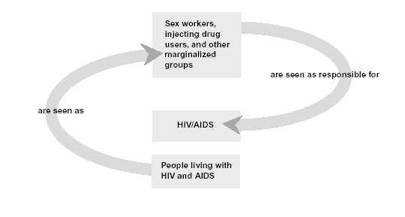
home
Stigma and Discrimination
Over the past two decades, HIV has emerged from an unknown virus, to a pandemic of astronomical proportions. Millions of people worldwide have already succumbed to this virus and millions more lives have been disrupted because of the pain and suffering of loved ones. Today there are approximately 40.3 million people living with HIV/AIDS and the number looks set to only rise. Entire societies will be feeling the effects of the pandemic for decades to come, most notably in Sub-Saharan Africa where the epidemic is most advanced. The virus itself is relatively difficult to contract when compared to others such as Influenza, but a myriad mix of social issues has allowed the virus to gain a major foothold in every nation around the world. The immense nature of this epidemic has led to mass fear and hysteria and many misconceptions of the virus. This has led to stigma and discrimination of those infected around the world as people seek to explain what they do not understand. Unfortunately, this only hinders the fight against the global pandemic and actually makes populations more vulnerable to infection. In order to effectively combat HIV/AIDS around the world, stigma and discrimination must be adequately addressed.
What is stigma and discrimination?
- People living with HIV are often believed (and led to believe) to deserve their status as a result of their doing something inherently wrong. By so alienating and laying blame on others who are somehow different, people can somehow remove themselves from any risk and not confront the issue for the problem that it is.
- Stigma and discrimination is caused by a lack of understanding of HIV, how it is spread, lack of access to treatment, irresponsible media coverage of the epidemic, the fact that AIDS has no cure, and already existing prejudices related to sexuality, disease, drug use, and death.
- Discrimination results when stigmatization is acted upon and can take many forms such as:
- Lack of access to equal health care
- Denial of equal opportunities for employment
- Denial of education to HIV positive children
- Detention of HIV infected persons
How does stigma and discrimination fuel the epidemic?
- Preventing people from coming forward and getting tested
- “Internalized Stigma”
- People with HIV can self-stigmatize themselves due to their own views on infected individuals as they seek to adjust to their new status
- This can especially occur in already stigmatized groups such as men who have sex with men (MSM), sex workers, injecting drug users and migrants,
- People who do not know they are HIV positive can in no way use this knowledge to plan for their future
- Do not seek treatment until they begin showing symptoms of AIDS-related illnesses, by which time it may be too late to effectively begin anti-retroviral treatment
- Use knowledge of their HIV infection to protect their family members from infection or plan for their family’s economic future after they have passed on.
- Leaving AIDS orphans
- Low perception of individual risk
- Individuals do not see themselves at risk for contracting HIV because they do not belong to one of the stereotypically stigmatized groups

(UNAIDS.org)
- Preventing people from disclosing their own status
- Individuals who know they are infected may not wish to disclose this information for fear of the stigma and discrimination that may follow. This does not always only occur to them, but also to others simply associated with them such as family members.
- Denial
- Denial goes hand in hand with discrimination. If one does not see themselves at risk, or see the potential for the epidemic to affect their community, they are at greater risk. Denial can even take the extreme form of not seeing the pandemic for the serious problem that it is. Either way, denial silences open conversation about the epidemic which hinders preventative measures.
What can be done?
In order to combat stigma and discrimination, all levels of society must be involved. The legal process must be involved at the international and national levels to ensure that the rights of HIV infected persons are protected. Measures must be put in place to ensure that this is enforced at the local level. In the end, education is the key. Stigma and discrimination is largely due to myths about HIV and its transmission. Education programs worldwide about the methods of HIV transmission (in particular the ways it is NOT transmitted), ways in which one can protect oneself from infection and treatment options will go a long way in the battle against stigma and discrimination and thus the battle against the worldwide pandemic as a whole.
Useful Links/Sources:
areyouhivprejudiced.org
avert.org
ilo.org
unaids.org